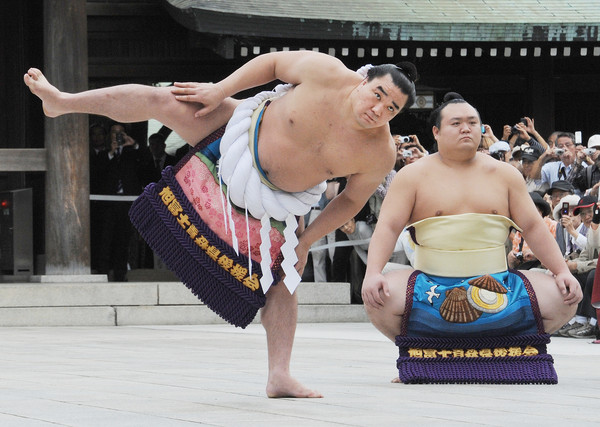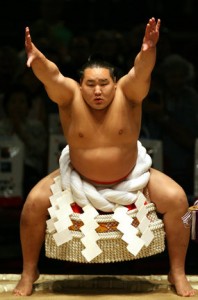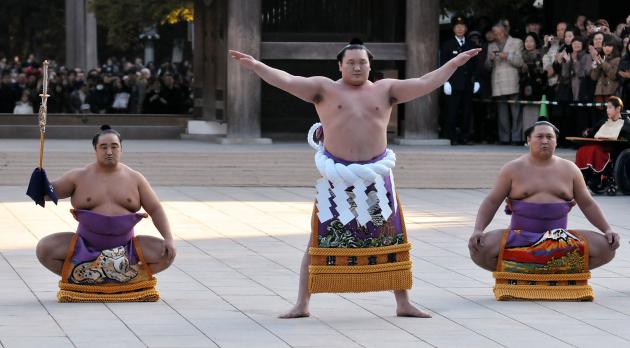
( AFP/Getty Images / September 28, 2012 ) Accompanied by sumo wrestler Takarafuji (R), new yokozuna, or grand champion, Harumafuji performs the ceremonial entrance into the ring at Meiji Shrine in Tokyo, Japan. The Mongolian sumo wrestler was promoted to the highest rank 'yokozuna.'
Yesterday there was a sumo ceremony at Meiji Shrine in Tokyo watched by 3000 people to celebrate the award of the top rank of yokozuna to the Mongolian wrestler, Harumafuji. The award means that the two top-ranking sumo wrestlers are now both Mongolian. Considering the links of sumo and Shinto, and of continental influences on early Shinto. this is a most interesting development.

Asashoryu (courtesy of lami japan)
Sumo and Shinto have a long and close history. The wrestling started as an entertainment put on before the kami, or ‘august dignitaries’. Many of the customs, such as purifying the ring with salt, attest to traditional Shinto practice. A rice rope and shide paper strips adorn the Mongolian wrestler in the picture above.
Since its foundation, Meiji Shrine has been associated with sumo ceremonies. The shrine was started in 1915 and completed in 1920 for Emperor Meiji and Empress Shoken (who died respectively in 1912 and 1914). The highest ranked sumo wrestlers dedicate the shrine every January.
Concerning the origins of sumo, the Kokugakuin encyclopedia has this to say…
In China, there existed from before the Former Han dynasty (202 B.C.E.–8 C.E.) a kind of wrestling resembling sumō that belonged to the miscellaneous arts of sangaku. Some of these arts entered Japan … That competitions were decided through sumō wrestling in ancient Japan can be inferred from the existence of Kofun-period haniwa clay figures representing wrestlers, as well as from myths and legends, such as that of the test of strength between the kami Takemikazuchi and Takeminakata, recorded in the Kojiki (712), or the wrestling match between Taima-no-Kuehaya of Yamato and Nomi-no-Sukune of Izumo on the seventh day of the seventh month in the seventh year of the reign of Emperor Suinin, as recorded in the Nihon shoki (720).
Sumō wrestling bouts were also held as divination rites at New Year’s to predict the outcome of the coming agricultural season. The Nihon shoki records that in the seventh month of 642, “strongman wrestling” was held on the occasion of a visit to Japan by an envoy from the Paekche kingdom. This is the first piece of historical evidence available for sumō. During the Nara period (710-784), sumō established itself as a court event.
 Mongolian grand sumo champion Yokozuna Hakuho performs the “ring entering ceremony” during a dedication at Meiji Shrine, Tokyo, Japan, on January 6, 2012. {Photo UPI/Keizo Mori}
Mongolian grand sumo champion Yokozuna Hakuho performs the “ring entering ceremony” during a dedication at Meiji Shrine, Tokyo, Japan, on January 6, 2012. {Photo UPI/Keizo Mori}
*****************************************************************************************************
For a full report of the ring-entering ceremony at Meiji Shrine by Harumafuji, please see here.

Leave a Reply